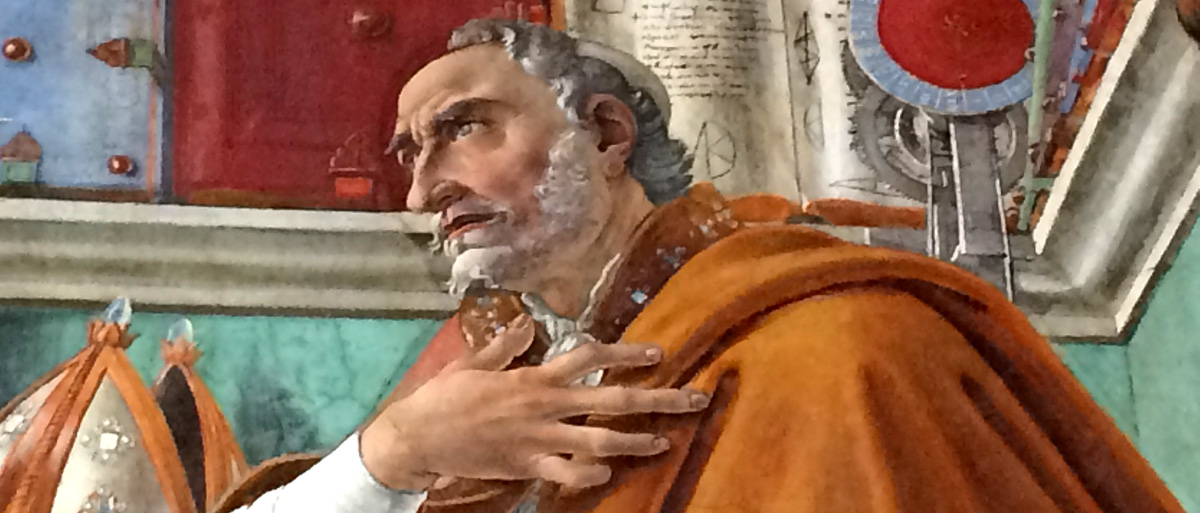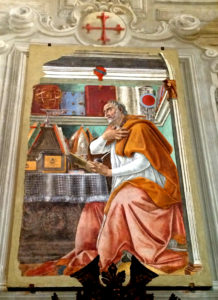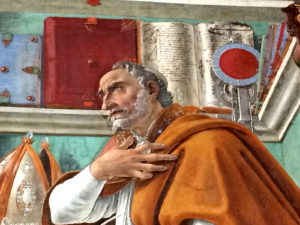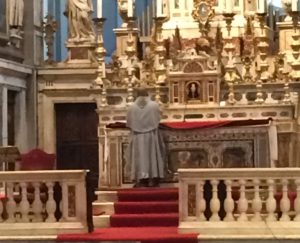 It was a stormy afternoon (not night), when I nervously entered Florence’s Ognissanti Church to check if Botticelli’s St. Augustine had finally returned. My last meeting had run late and I was out of breath. Tomorrow my flight was leaving at sunrise, so this would be my last chance. I walked at top speed nearly the whole way, because it was close to closing time. There was no time to take more than a few irresistible last looks at the city (Santa Maria Novella, the Arno). Luckily, a thunderstorm had just ended, thinning the crowds of tourists, but the stone pavement was slippery in spots along the way.
It was a stormy afternoon (not night), when I nervously entered Florence’s Ognissanti Church to check if Botticelli’s St. Augustine had finally returned. My last meeting had run late and I was out of breath. Tomorrow my flight was leaving at sunrise, so this would be my last chance. I walked at top speed nearly the whole way, because it was close to closing time. There was no time to take more than a few irresistible last looks at the city (Santa Maria Novella, the Arno). Luckily, a thunderstorm had just ended, thinning the crowds of tourists, but the stone pavement was slippery in spots along the way.
For the past three years, I had made this pilgrimage, only to experience disappointment. Ognissanti, one of the important neighborhood parish churches of Florence, has quite a few treasures, like its beautifully restored, spectacular 15 foot tall crucifix by Giotto. It is also the final resting place of Sandro Botticelli, his tomb near the feet of his unrequited love, Simonetta Vespucci, the model for The Birth of Venus and other masterpieces. Visitors from around the world leave love notes addressed to the artist there.
But one of my favorite Botticelli frescoes, St. Augustine in his Study (1480), has been missing for years, its place taken by a mounted, fading color photocopy. Just across the aisle hangs a fresco designed to be the other half of a pair — Domenico Ghirlandaio’s St. Jerome in his Study (1480). St. Jerome appears to be looking across at St. Augustine. Leaning his head in his hand, he seemed to, while trying to be philosophical, share my frustration looking across at the poor copy.

Domenico Ghirlandaio, St. Jerome in his Study, 1480
When I arrived, I was relieved that the door could still be pushed open. Ognissanti was not yet closed. The late afternoon sunset had been in my eyes the whole way, so it took some time to adjust to the dark church’s lighting. Only a few visitors were inside. The guardian monk who I had talked to in February sat sleepily in the corner on the other side of the doors.
I made my way quickly to the spot – halfway up the nave on the right. I tried to focus my eyes, because something had changed. I moved in closer to check and then looked around to see if anyone else had noticed. The monk in the corner seemed uninterested.

Sandro Botticelli, St. Augustine in his Study, 1480
St. Augustine was back and looked wonderful. The fresco had been cleaned while it was away and the colors seemed remarkably fresh, its lines sharp and clear. The year-long restoration was handled by the Opificio, the famous national labs in Florence. Since then, it was in an exhibition of Renaissance art in Brazil for a year, and then finally toured Japan over the past year (as I learned from one of our readers). The Japanese tour ended in early April and two weeks before I arrived in mid-May, St. Augustine had finally returned to his home.

Sandro Botticelli, St. Augustine in his Study, 1480, detail
After I spent a long time soaking in St. Augustine’s new clarity, I made my way over to the Franciscan monk I had met in February, to see how he felt. I reminded him of our conversation and then asked in my rough Italian, “And you are happy, yes?” His look was a mix of a smile and skepticism.
“Yes, I’m happy but…well, next they want to take St. Jerome to Korea.” So, the other half of the pair, by Ghirlandaio, was next on the Italian Ministry of Culture’s hit list. The monk then leaned in to me and whispered, “and they are threatening to take Giotto’s Crucifix to Russia.”
He then shrugged his shoulders Italian-style and wearily walked to the altar as part of his preparations to close Ognissanti for the evening. While he did, I returned to take another look at Botticelli’s St. Augustine and what I hoped was not a last look at Ghirlandaio’s St. Jerome.


The Botticelli is missing again! To find out where it’s gone, check out our Facebook page:
https://www.facebook.com/lewisartcafe/photos/a.1413582715588623.1073741828.1396120544001507/1924407837839439/?type=3&theater